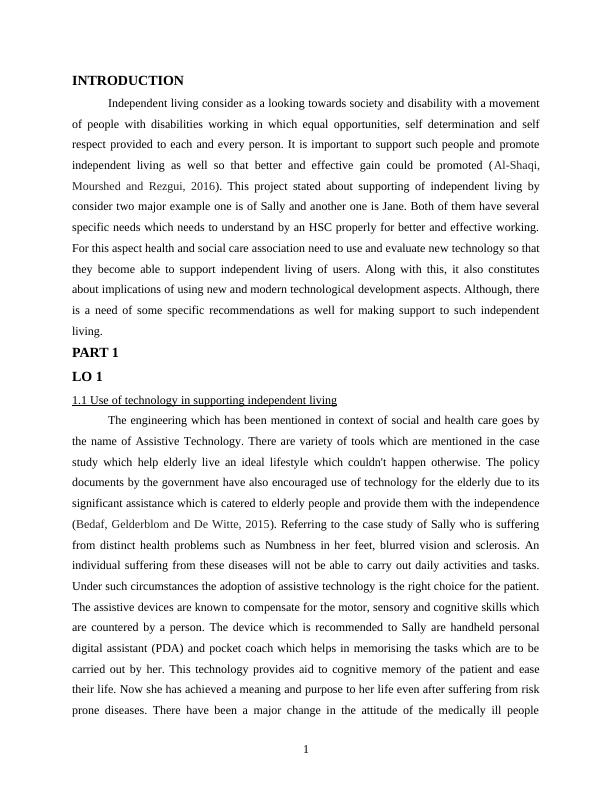Supporting Independent Living - HSC
Added on 2020-06-03
11 Pages4105 Words106 Views
SupportingIndependent Living

Table of ContentsINTRODUCTION...........................................................................................................................1PART 1............................................................................................................................................1LO 1.................................................................................................................................................11.1 Use of technology in supporting independent living........................................................11.2 Barriers to use of technology in health and social care....................................................21.3 Benefits of technologies to service user as well as organisation......................................2LO 2.................................................................................................................................................32.1 Explanation of health and safety considerations in use of technologies..........................32.2 Ethical considerations in use of technologies...................................................................42.3 Impact of recent technological development on health and social care...........................5PART 2............................................................................................................................................63.1 Identify the specific needs of an individual requiring support to live independently......63.2 Recommendations for technologies use which might support the independent living....63.3 Usefulness of technology for users of health and social care services.............................7CONCLUSION................................................................................................................................8REFERENCES................................................................................................................................9

INTRODUCTIONIndependent living consider as a looking towards society and disability with a movementof people with disabilities working in which equal opportunities, self determination and selfrespect provided to each and every person. It is important to support such people and promoteindependent living as well so that better and effective gain could be promoted (Al-Shaqi,Mourshed and Rezgui, 2016). This project stated about supporting of independent living byconsider two major example one is of Sally and another one is Jane. Both of them have severalspecific needs which needs to understand by an HSC properly for better and effective working.For this aspect health and social care association need to use and evaluate new technology so thatthey become able to support independent living of users. Along with this, it also constitutesabout implications of using new and modern technological development aspects. Although, thereis a need of some specific recommendations as well for making support to such independentliving. PART 1LO 11.1 Use of technology in supporting independent livingThe engineering which has been mentioned in context of social and health care goes bythe name of Assistive Technology. There are variety of tools which are mentioned in the casestudy which help elderly live an ideal lifestyle which couldn't happen otherwise. The policydocuments by the government have also encouraged use of technology for the elderly due to itssignificant assistance which is catered to elderly people and provide them with the independence(Bedaf, Gelderblom and De Witte, 2015). Referring to the case study of Sally who is sufferingfrom distinct health problems such as Numbness in her feet, blurred vision and sclerosis. Anindividual suffering from these diseases will not be able to carry out daily activities and tasks.Under such circumstances the adoption of assistive technology is the right choice for the patient.The assistive devices are known to compensate for the motor, sensory and cognitive skills whichare countered by a person. The device which is recommended to Sally are handheld personaldigital assistant (PDA) and pocket coach which helps in memorising the tasks which are to becarried out by her. This technology provides aid to cognitive memory of the patient and easetheir life. Now she has achieved a meaning and purpose to her life even after suffering from riskprone diseases. There have been a major change in the attitude of the medically ill people1

towards their life. The major benefits of assistive technologies can be ascertained throughimprovement in quality of life and significant reduction in accident which would happenotherwise. 1.2 Barriers to use of technology in health and social careThere is no denying in the fact that the use of assistive technology have carried a positiveimpact on the life of Sally. She is now able to carry out her roles and responsibilitiesindependently. However there are problem which arises with successful implementation ofassistive technologies in context of patients of health and social care. The suitability relating topatients is another obstacle which is encountered in successful adoption of technology in healthand social care. The patients in this case is suffering from Multiple sclerosis which calls for idealhealth and social services along with adoption of technology. The general practitioner who havesuggested the use of this technology lacks specialisation and therefore PDA may not be the righttechnology for this disease. The person is experiencing blurred vision and numbness in her bodyand her cognitive domain seems to be working fine. Therefore there is lesser need for Pocketcoach may not be the ideal choice. The another barrier which is encountered is that there is alimit to which technology can be utilised. For instance a person suffering from severe diseasesmay not find technology helpful as he needs to be under surveillance 24*7. In the case ofpsychological disorder there is a lesser relevance for the technology. The patients suffering fromdepression, emotional stress and disorders can not be resurrected with the help assistivetechnologies as they required personalised care. The another challenge which is encountered bythe assistive technologies is that they are prone to malfunctioning and breakdowns which mayhinder the circumstance of patients in health and social care. Under such circumstances it isessential for a person to know the person to be consulted to repair the machine which comes atits own price. Ignoring the technical complexities it can be said that technology assist a person inattaining a degree of independence and purpose which can not be attained otherwise. 1.3 Benefits of technologies to service user as well as organisationIt can be seen that assistive technologies assist patients in living an improved life(Blackman and et. al., 2016). The major benefits which are availed by a service user is asfollows: 2

End of preview
Want to access all the pages? Upload your documents or become a member.
Related Documents
HNC/HND Supporting Independent Livinglg...
|16
|4050
|28
Supporting Independent Living | Assignmentlg...
|12
|4252
|37
Supporting Independent Living - Assignmentlg...
|11
|3886
|120
Supporting independent living in the context of health and social care technologieslg...
|12
|4095
|103
Supporting Independent Living (doc)lg...
|11
|3772
|394
Supporting Independent Living: Understanding the Use of Technology and Implementations of Developments in Health and Social Carelg...
|19
|4813
|59